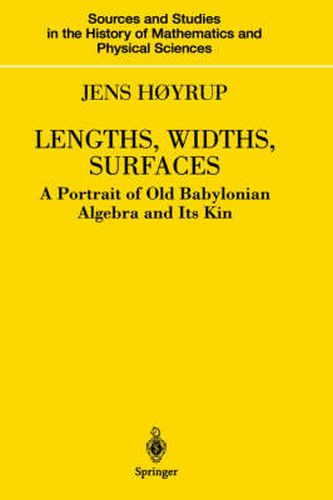Readings Newsletter
Become a Readings Member to make your shopping experience even easier.
Sign in or sign up for free!
You’re not far away from qualifying for FREE standard shipping within Australia
You’ve qualified for FREE standard shipping within Australia
The cart is loading…






This title is printed to order. This book may have been self-published. If so, we cannot guarantee the quality of the content. In the main most books will have gone through the editing process however some may not. We therefore suggest that you be aware of this before ordering this book. If in doubt check either the author or publisher’s details as we are unable to accept any returns unless they are faulty. Please contact us if you have any questions.
In the 1920s it was recognized, largely as a result of work by Otto Neugebauer and his colleagues that Babylonian cuneiform texts included many mathematical texts. These were chiefly concerned with metrology and computation, but some also appeared to deal with algebra. But then, what could have been the reasons that induced the Babylonians to work on, for example, second-degree equations? In this new examination of the texts, Jens Hoyrup proposes a different interpretation, based on the fact that the tablets are almost entirely students’ workbooks. The knowledge of mathematics expressed in these tablets is entirely practical, for use in surveying, accounting, and building, rather than theoretical. Hoyrup argues that the notion of algebraic manipulation, like other parts of a theoretical mathematics is indeed a later invention. Craftsmen, he argues, prefer to know how to solve a problem, rather than why the answer will be true, and it is only the latter attitude that characterizes mathematics; the former is, perhaps, more akin to modern engineering. The book provides a detailed reading of many tablets and a careful examination of the context in which they were produced.
$9.00 standard shipping within Australia
FREE standard shipping within Australia for orders over $100.00
Express & International shipping calculated at checkout
This title is printed to order. This book may have been self-published. If so, we cannot guarantee the quality of the content. In the main most books will have gone through the editing process however some may not. We therefore suggest that you be aware of this before ordering this book. If in doubt check either the author or publisher’s details as we are unable to accept any returns unless they are faulty. Please contact us if you have any questions.
In the 1920s it was recognized, largely as a result of work by Otto Neugebauer and his colleagues that Babylonian cuneiform texts included many mathematical texts. These were chiefly concerned with metrology and computation, but some also appeared to deal with algebra. But then, what could have been the reasons that induced the Babylonians to work on, for example, second-degree equations? In this new examination of the texts, Jens Hoyrup proposes a different interpretation, based on the fact that the tablets are almost entirely students’ workbooks. The knowledge of mathematics expressed in these tablets is entirely practical, for use in surveying, accounting, and building, rather than theoretical. Hoyrup argues that the notion of algebraic manipulation, like other parts of a theoretical mathematics is indeed a later invention. Craftsmen, he argues, prefer to know how to solve a problem, rather than why the answer will be true, and it is only the latter attitude that characterizes mathematics; the former is, perhaps, more akin to modern engineering. The book provides a detailed reading of many tablets and a careful examination of the context in which they were produced.